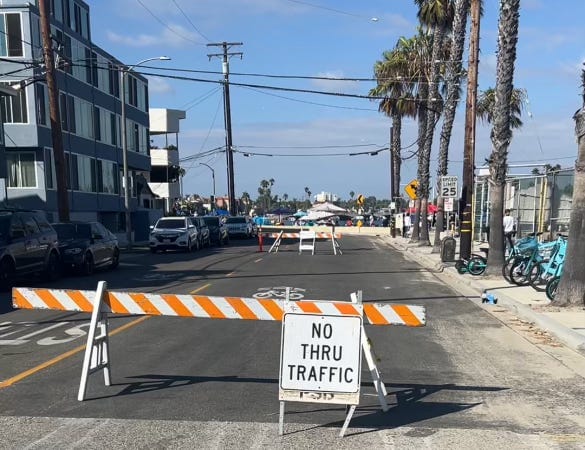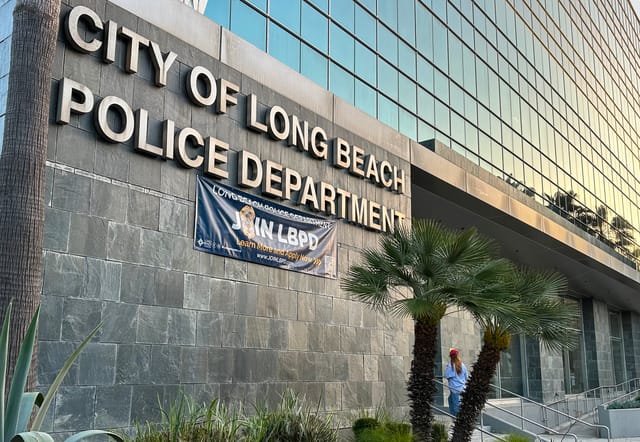A proposed 200-foot tower could obstruct Long Beach Airport operations, FAA says. To what extent?
Long Beachers are invited to weigh in on Relativity’s proposed tower, which could negatively affect nearby residential neighborhoods, according to various aviation associations and groups.

In a preliminary investigation, the Federal Aviation Administration says that a proposed 200-foot-tall tower adjacent to Long Beach Airport could obstruct daily operations at the airfield.
To determine effects on safety and efficiency, the agency is conducting an aeronautical study, which will include public comment.
Boycott the Post. Become a Watchdog.
Rocket developer and launch service provider Relativity Space proposed constructing the test stand at its headquarters — the former Boeing C-17 site on the west side of the airport — to “model environmental stresses a rocket would experience in space,” including hydraulic or mechanical system pressure, tension and compression, a spokesperson said in a March 20 email.
No engine tests, hot fires or rocket launches would occur in Long Beach, they added.
Despite preliminary findings released by the FAA on Feb. 29, Relativity maintains that the tower would “not impact nominal flight paths.” While that has yet to be determined by the administration, spokesperson Ian Gregor said that could end up being the case.
“The fact that it punches up into protected airspace doesn’t necessarily mean that it’s a hazard,” Gregor said in a March 18 interview. “Something could exceed standards but not interfere with any air maneuvers.”
Numerous aviation groups, however, have already argued that such a large tower so close to the airport poses a danger and could negatively impact surrounding neighborhoods by changing flight paths. These groups are urging the public to submit comments to the FAA by the April 6 deadline using study number “2024-AWP-238-OE.”
Alex Gertsen, director of airports and ground infrastructure for the National Business Aviation Association, said that, while the organization appreciates Relativity’s contributions to aerospace and supports its goals, the placement of the tower is simply too close to the airfield for comfort.
“We hope they consider potentially finding another location a bit further away from the airport where this height won’t be as impactful to flight operations,” Gertsen said.
“Having an obstruction like that is hazardous,” Gertsen continued. “It’s a concern to air navigation.”
More from the Watchdog
Column: Cars are banned from Bay Shore Avenue this spring break. Let’s keep it that way
Jake Gotta • Apr 2, 2024

A popular stretch of Bay Shore Avenue between Ocean Boulevard and Second Street will be closed to traffic from 9 a.m. to 5 p.m. through April 7 in Belmont Shore, according to Long Beach Public Works. The city has cl…
Read full story →
Helicopters would be the most impacted, Gertsen said, noting that he recently had the opportunity to fly one at Long Beach. If the tower were erected, he said it would force helicopters out over the nearby neighborhood, which would mean more noise for residents.
Curt Castagna, president of the Long Beach Airport Association as well as president and CEO of the National Air Transportation Association, explained that the general rule of thumb for aircraft is to give a berth equal to twice the height of a structure, meaning there would be roughly a 400-foot diameter around the tower that aircraft would avoid flying through.
Outside of the safety concerns, Castanga noted that the project would not have to go before the Planning Commission or City Council for approval, meaning no there will be no public comment outside of the FAA study.
“If the FAA approves it and the city ultimately allows this thing to go up, then great,” Castagna said, “as long as it was done with a process that was transparent so the neighbors understand what’s coming.”
The city’s Planning Bureau confirmed Castagna’s concern, saying the project complies with the Globemaster Corridor Specific Plan, which outlines development standards and regulations in that area.
“No further entitlements are required,” city spokesperson Richard de la Torre said in a March 20 email. “Therefore, there is no requirement to go back to either the Planning Commission or the City Council since both bodies have already considered and adopted the [plan].”
Regardless of the study’s findings, the agency will merely submit recommendations to city staff, FAA spokesperson Gregor said. The final decision falls on the city, he noted.
Thank you for reading Long Beach Watchdog. This post is public so feel free to share it.
Based on the coordinates listed for each corner of the tower, the structure would be roughly 41 feet by 79 feet. It would assist in the development of Relativity’s 270-foot-tall Terran R rocket, which will be completely 3D printed and have the capacity to carry payloads that weigh up to 73,855 pounds.
Construction on the test stand will begin immediately after permits are received, the Relativity spokesperson said. The project is expected to take about a year to complete.
Relativity also submitted a 131-foot tower proposal to the FAA for consideration. On Feb. 29, the administration announced it had determined the shorter tower “does not exceed obstruction standards,” records show.
While the space company continues to push for the taller test stand, the spokesperson said it would settle for the shorter one if necessary.
“We are working with the city, the Federal Aviation Administration (FAA), and airport leadership to review the height at which we can meet our technical objectives while maintaining a safe airspace for all,” the spokesperson said. “We are committed to being good neighbors to the community, ensuring minimal disruption.”
We need your support.
Subcribe to the Watchdog today.
The Long Beach Watchdog is owned by journalists, and paid for by readers like you. If independent, local reporting like the story you just read is important to you, support our work by becoming a subscriber.





